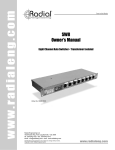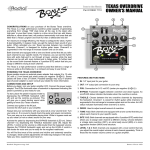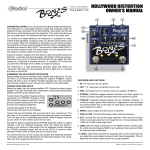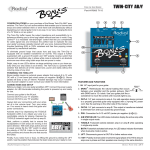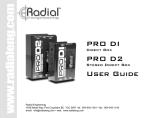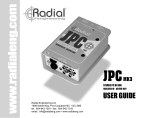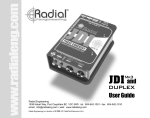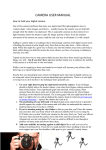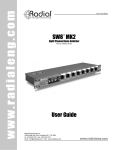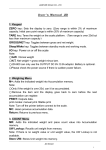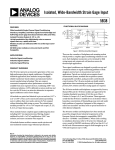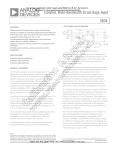Download www.radialeng.com
Transcript
www.radialeng.com STEREO PASSIVE DIRECT BOX USER GUIDE Radial Engineering Ltd. 1588 Kebet Way, Port Coquitlam BC V3C 5M5 Tel: 604-942-1001 • Fax: 604-942-1010 email: [email protected] • www.radialeng.com STEREO PASSIVE DIRECT BOX USER GUIDE TABLE OF CONTENTS PAGE Introduction ........................................................................................................................................ 1 Input & output panel features ............................................................................................................ 2 Connecting the JPC........................................................................................................................... 3 Direct Box Basics .............................................................................................................................. 4 Magnetic Bridge................................................................................................................................. 5 ¼" Inputs and Hi-Cut Filter ................................................................................................................ 6 Merge, 180° Polarity and XLR-In Select ........................................................................................... 7 Block diagram and specifications ...................................................................................................... 8 Warranty ............................................................................................................................. Back cover Thank you and congratulations on your purchase of the world's finest direct box! The Radial JDI Duplex is the stereo version of the highly acclaimed JDI and is without a doubt the finest passive direct box available today. The JDI Duplex is very unique in that it does not color or alter the sound in any way. This ensures that natural tone and harmonic balance is retained, bringing out the very essence of the instrument. The Duplex employs two Eclipse® transformers for unmatched audio performance, exceptional noise rejection and high signal handling. This makes it ideal for acoustic guitar, bass and keyboards. In fact, just about any audio signal is transformed gracefully without artifact. We suggest that you read this manual before using the JDI so that you can maximize its potential. Please log onto the Radial Engineering website at www.radialeng.com for further details and FAQ updates. We invite you to forward any comments, questions or suggestions to [email protected]. We’d love to hear from you. Enjoy! ® True to the Music Introduction The Radial JDI Duplex is a full-feature, stereo passive direct box designed to enhance connectivity, reduce noise, and simplify the hectic life of the touring professional, broadcast engineer or AV integrator. It is plug-and-play easy to use while delivering the utmost sonic quality. Like the Radial JDI, the Duplex employs two high-performance Eclipse audio transformers and the same pristine audio signal path that has made the JDI the industry standard. It features exceptional signal handling with virtually zero phase shift or harmonic distortion, while remaining linear across the entire audio spectrum. When driven to extremes, the natural transformer saturation and resulting warm Bessel curve makes the Radial Duplex the perfect choice for smoothing out highly dynamic instruments such as digital pianos and electronic drums that can sound harsh when pushed. Transformer isolation provides the additional benefit of eliminating troublesome ground loops that can cause hum and buzz in the audio system. This 'Swiss Army knife' DI is equipped with ¼" connectors for instruments, RCA connectors for unbalanced -10dB consumer electronics and XLR inputs for +4dB professional line sources. Radial's innovative book-end design provides protective zones on the front and rear to keep connectors and switches out of harm's way. The 14 gauge I-beam inner frame adds tremendous rigidity to eliminate outside stresses that could torque the PC board and cause premature solder joint and trace failure. The steel outer shell couples with the transformer's mu-metal shield to protect against stray magnetic fields from power transformers or lighting systems that could cause interference. Finally, a full-bottom, no-slip pad works double-duty by providing both mechanical and electrical isolation. The Radial JDI Duplex delivers outstanding connectivity, superlative audio and quiet dependable performance. Radial Engineering Ltd. 1 JDI • Duplex mk4 User Guide ® True to the Music Features & Functions 1. HI-CUT FILTER: Works when the PAD is engaged to reduce hiss and noise. 2. -15dB PAD: Allows loud signals from keyboards to be connected without distortion. 3. MERGE: Turns the input and thru jacks into a passive mixer to sum stereo signals to mono. 4. ¼" PHONE & RCA JACKS: For instruments and line-level sources like CD players. 5. XLR-IN: Activates the +4dB XLR input and disconnects the ¼" & RCA jacks. 1 2 3 4 5 6 6. BOOK-END DESIGN: Creates a protective zone around the jacks and switches. 7. +4dB XLR INPUT: For balanced line-level sources like mixing consoles and pro VTRs. 8. 180° POLARITY REVERSE: Inverts signal polarity at the XLR output to help align phase when mixing with mics. 9. XLR OUTPUT: 600 Ohms balanced mic-level output for runs to 1000' (300m) without noise. 10. GROUND LIFT: Helps reduce noise caused by ground loops; lifts pin-1 on both channels. 11. FULL BOTTOM PAD: Improves electrical insulation and mechanical isolation. 7 8 9 10 11 12 12. I-BEAM REINFORCED: 14-guage steel enclosure with extra stiff i-beam shape makes it impossible to torque the PC board and eliminates cold solder joints. Durable baked enamel finish. Radial Engineering Ltd. 2 JDI • Duplex mk4 User Guide ® True to the Music To Start: The JDI DUPLEX Quick Start This section is for advanced users — it provides a quick set of instructions for those that are familiar with direct boxes and gets right down to action! We suggest that you read through the entire manual for a better understanding of your JDI. 1. Make sure all switches are in the outward position. 2. Plug the instrument into the INPUT. 3. Connect the ¼" THRU jack to the instrument amplifier or keyboard mixer. Caution! When connecting or disconnecting any audio device always ensure the power is off or all levels are set to zero. This practice will reduce the opportunity for any noise such as a capacitor discharge from being sent through the amplifier to the speakers, which could cause a big bang in your sound system or even cause a speaker to blow. This is especially true with phantom powered equipment. 4. Connect the XLR OUTPUT to the PA or mixing console. 5. Slowly turn up the input level at the mixer and listen. 6. If you hear distortion, depress the –15dB PAD switch. 7. If you hear buzz and hum caused by ground loops, depress the GROUND switch. The Radial Duplex is a passive direct box and does not require any external power such as phantom or batteries to make it work. Just plug-in and play! Radial Engineering Ltd. See the ‘Features and Functions’ section for information about using the merge, hi-cut filter, and line-level inputs. You are ready to go! Now... close your eyes and listen. The Duplex is without a doubt, one of the most musical DI boxes ever manufactured. 3 JDI • Duplex mk4 User Guide ® True to the Music Direct Box Basics The name ‘direct box’ comes from ‘direct insertion box’. This is why these marvelous contraptions are also called DI’s. ‘Direct Insertion’ means exactly that: to insert an eletronic signal directly into a mix point or recorder. This is opposed to a microphone which transduces acoustic vibrations into an electronic signal. Because the signal from an instrument like a synthesiser is already electronic, we can skip the transducing part and inject it directly into the audio system using a DI. The Magic of a Great Transformer The Radial Duplex is a passive direct box. This means that it employs a transformer to convert the impedance and balance the signal. Many Radial products incorporate Eclipse® audio transformers which are expensive, but to an audiophile, these transformers are worth their weight in gold. To understand how a passive DI works we have to understand DI transformers. A transformer is a simple device. It is basically made up of three components: the primary or input coil, the core material and the secondary or output coil. The audio signal enters the primary coil and according to Faraday's law of electromagnetism, the current is converted into a pulsing magnetic field. The metal core acts like a conduit to contain the magnetic field and concentrate it into the secondary coil. The secondary coil, bathed in modulating lines of magnetic flux, converts the magnetism back into an audio signal through induction. Varying the number of windings on the primary and secondary coils allows us to control the input and output impedance ratio. This is where the specification ‘10k : 150 Ohms’ for transformers comes from. Direct boxes allow direct insertion by performing the important functions of impedance matching, level convertion and signal balancing. This means that they take the high impedance, unbalanced output from a guitar or keyboard and ‘transform’ it to the low impedance, mic-level signal used in a balanced sound system. By their design, balanced signals inherently cancel noise and due to the lower impedance, signals can travel much further without degradation like high frequency loss. High impedance, unbalanced signals are the norm in electronic musical instruments and consumer audio devices. The direct box interfaces the two and allows the best sound, least noise and fullest frequency response. This is why low impedance, balanced signals are the standard in professional recording, broadcast and live sound. LAMINATED CORE There are a couple of important things to understand about the XLR output. This output taps the instrument signal before it goes to the musician's effects and amplifier. This allows the mix engineer to capture the signal before it is modified by the musician. This is important because what may sound good on stage to the musician may not necessarily sound good in the venue. Another important fact is that the level of the XLR output is mic-level signal. This allows the Duplex to be used along side other microphone signals without introducing cross-talk or overdriving the mixing consoles input. PRIMARY WINDING Radial Engineering Ltd. 4 MAGNETIC BRIDGE SECONDARY WINDING JDI • Duplex mk4 User Guide ® True to the Music Magnetic Bridge The beauty of a transformer is that there is no 'hard' electrical connection between the primary and the secondary coils. The signal is ‘transformed’ from electrical energy to magnetic, then back to electrical; in effect, a ‘magnetic bridge’ betweein the input and the output. The benefit is that only alternating current (audio signal) can cross this bridge. Noise like hum and buzz mainifest as DC or direct current and are blocked by the transformer. Thus 60-cycle hum caused by ground loops are eliminated. The left diagram below shows the ground loop through the power cable and the signal cable that connects the keyboard to the mixer. The right diagram shows how an isolation transformer, like the one found in the Duplex DI, breaks the loop and keeps DC noise from passing into the audio signal. Dotted line shows ground loop path. Low Frequency Phase Shift An audio laboratory test called ‘The Green Report’ (visit www. radialeng.com for details) pitted the JDI (single channel version of the Duplex) against three other direct boxes commonly used in professional audio. All the direct boxes tested well for phase shift at 1kHz, but as the frequency dropped, the ‘ugly truth’ started to appear. One popular DI was almost 20º out of phase at 20Hz while another was almost 40º out of phase! The Duplex tested at less than 4º off the mark, making it the most phase accurate DI on the planet. Less phase shift equals tighter and more coherient low frequency response as well as an indicator of overall quality. Transformer inserted into the audio path breaks the loop. The transformer will isolate noise caused by ground loops when the ground switch is depressed. This disconnects pin-1 at the XLR output. If you hear hum or buzz try depressing the GROUND switch. Radial Engineering Ltd. 5 JDI • Duplex mk4 User Guide ® ® True to the Music The ¼” INPUT and THRU Connectors The Duplex features two ¼” jacks per channel. These are designed to accept instrument inputs from basses, guitars, keyboards, drum machines, etc. The source instrument is normally connected to the ¼” input jack. The ¼” thru jack is normally used as a parallel connection to drive the instrument signal to the musician's on-stage amplifier. -15dB PAD Today, many acoustic guitars and basses have battery powered active pre-amplifiers that boost their pickup output signal. These high gain pre-amps often generate between 2 to 7 volts at their outputs. This high voltage can saturate the input of most direct boxes causing a harsh square wave distortion. This is most prevalent with active phantom powered direct boxes that simply do not have sufficient headroom or rail voltage to handle these transients. Using the 'thru' jack with an on-stage amplifier allows both the musician and the engineer to work with the original signal direct from the instrument. This way, the musician can set up his stage sound with his own EQ while the audio engineer can process the instrument to sound good in the venue through the PA system. The Duplex is designed to handle these signal levels without fear of overloading and is one of it's main advantages. However, you may occasionally encounter devices with extremely high output levels such as CD players and DJ mixers that can overdrive the circuit or saturate the transformer. For these rare occasions, the Radial Duplex is equipped with a -15dB pad to ensure a clean and distortion-free signal is obtained. If you hear distortion when working with one of these high output devices simply depress the PAD switch and adjust the mixing console input gain to suit. Some instruments do not use on-stage amplification. It is common for instruments such as acoustic guitars to be connected directly to the PA system through the Duplex. This allows the signal to feed the stage snakes, monitor mixer for foldback and main PA, just like microphone signals do. In this case, the thru jack would not be used. Hi-Cut Filter The high-impedance ¼” and RCA inputs for each channel can be routed through the high frequency filter by depressing the HI-CUT switch. This filter can also be called a low-pass filter because it gently attenuates frequencies above 10k Hz while letting lower frequencies pass through unaffected. Merge The Duplex features an innovative ‘merge’ function that turns the ¼” input and thru jacks into a passive summing mixer. Depressing the merge switch introduces a resistive mixer circuit that sums or combines the signals appearing at these jacks and sends a mono signal to the XLR output. The merge function allows two sources to connect to each Duplex channel. This can be used for stereo sources such as keyboards or CD players to save valuable channels on the snake and the mixing console. It can also be used to connect two mono keyboards to one Duplex channel. The filter is designed to help remove high frequency noise or 'hiss' from older or consumer audio devices. Many of these types of audio devices may sound just fine connected to a typical home playback system but when connected to a 50,000 watt PA or high-resolution 24bit recording system, the high frequency hiss can become an issue. If you hear a lot of hiss try depressing the filter switch. Radial Engineering Ltd. To merge, simply connect two instruments with similar output levels into the IN and THRU jacks, depress the MERGE switch to the ON position and you are set to go. The internal resistive mixer is set up to do this without introducing any problems such as phase cancellation. 6 JDI • Duplex mk4 User Guide ® ® True to the Music XLR - In Select The live mixing console is no longer limited to mixing mics and instrument signals. Todays live mixers see a significant amount of channels from balanced line-level devices like broadcast video, DAW tracks and satellite feeds. The balanced XLR-IN feature is designed to directly interface balanced line-level devices with the mic snakes and preamps allowing line sources to be treated like other mic and DI signals on stage. At the same time, balanced devices are isolated from hum and buzz caused by ground loops and troublesome noise from less than ideal consumer electronic sources. Balanced XLR Output Each Duplex channel features a mic-level, low impedance balanced output jack that uses a standard XLR male connector. This jack is wired to the AES (Audio Engineering Society) standard with pin-1 ground, pin-2 hot and pin-3 cold. Today, pretty much all equipment is manufactured using this standard. Connections are made from the XLR output to the input of the mixing console or to a standard mic pre-amplifier. The Duplex is well suited to interface with concert snake systems and splitters where mic and direct box signals are directed to several destinations at the same time such as recording, monitor, broadcast and front-of-house mix positions. 180º Polarity A polarity reverse switch toggles the XLR pin-2 and pin-3 as the ‘hot’ or positive signal. This provides operational benefits. First, interfacing with older audio equipment that use the pin-3 as hot is simply a matter of depressing the polarity reverse switch. Secondly, when combining mic and Duplex signals from the same instrument, one sometimes encounters ‘phase’ problems because of the time delay between the direct signal and the mic signal. Reversing one of the signal polarities can correct phase or lessen its effects. This same process can be used while recording microphone and direct box signals to one track to provide the engineer with another ‘tonal palette’ to experiment with. In a live performace situation, the polarity reverse can sometimes reduce feedback from acoustic instruments. Ground Lift It is common practice to ground all electrical devices in a sound system. Proper grounding assures safe use and generally helps reduce system noise. As the Radial Duplex is an interface, it is often placed between two grounded AC powered devices such as a keyboard and a mixer. Often these two devices will be connected to different AC outlets that may have very different ground reference potentials. In this commom situation, an audio device has two paths to ground. One path is through it's power cable, the other path follows the audio signal cable to the second device and finally to ground through the second devices power cable. This creates what is commonly known as a ground loop. This is a problem because some stray DC current may exist inside an audio device, especially one with a poorly designed grounding scheme. This current should flow to ground through the power cable but some of it will find it's way onto the audio cable's ground where it bleeds into the sound as 60-cycle hum or buzz. This noise is often referred to as a ground loop noise. Radial Engineering Ltd. 7 JDI • Duplex mk4 User Guide ® True to the Music Block Diagram Specifications ¼" HI-CUT 10kHz RCA CH-1 INPUT MERGE CH-1 THRU -15dB PAD POLARITY 180º XLR-IN Switch RCA CH-1 XLR OUTPUT XFORMER Audio circuit type: Passive, transformer isolated Frequency response: 20Hz ~ 20KHz (± 0.2dB) Phase deviation: 0.3° @ 100Hz; 5° @ 20Hz Maximum input: +21dB @ 20Hz Total harmonic distortion: 0.006% @ 1kHz Common mode rejection: 100dB @ 60Hz (unbalanced source) ¼" -20dB PAD CH-1 XLR Line In GND LIFT ¼" CH-2 INPUT XLR-IN Switch RCA MERGE RCA CH-2 THRU -15dB PAD 140k Ohms, unbalanced Output impedance: 600 Ohms, balanced Features -20dB PAD CH-2 XLR Line In Input impedance: XFORMER POLARITY 180º CH-2 XLR OUTPUT HI-CUT 10kHz ¼" Input pad: -15dB 180° polarity reverse: Inverts signal polarity Ground lift: Disconnects pin-1 at XLR outputs Merge: Input summing mixer High cut: Low-pass filter (-3dB @ 15kHz) XLR input: Switchable balanced XLR input XLR configuration: AES standard (pin-2 hot) General Construction: 14 gauge steel, baked enamel finish Size: 6.25"w x 5.0"d x 1.875"h (159 x 127 x 48mm) Weight: 2.9 lb (1.32 kg) Power: Passive, no power required Warranty: Radial 3-year, transferable Specifications are subject to change without notice. Radial Engineering Ltd. 8 JDI • Duplex mk4 User Guide RADIAL ENGINEERING LTD. (“Radial”) warrants this product to be free from defects in material and workmanship and will remedy any such defects free of charge according to the terms of this warranty. Radial will repair or replace (at its option) any defective component(s) of this product (excluding finish and wear and tear on components under normal use) for a period of three (3) years from the original date of purchase. In the event that a particular product is no longer available, Radial reserves the right to replace the product with a similar product of equal or greater value. In the unlikely event that a defect is uncovered, please call 604-942-1001 or email [email protected] to obtain an RA number (Return Authorization number) before the 3 year warranty period expires. The product must be returned prepaid in the original shipping container (or equivalent) to Radial or to an authorized Radial repair center and you must assume the risk of loss or damage. A copy of the original invoice showing date of purchase and the dealer name must accompany any request for work to be performed under this limited and transferable warranty. This warranty shall not apply if the product has been damaged due to abuse, misuse, misapplication, accident or as a result of service or modification by any other than an authorized Radial repair center. THERE ARE NO EXPRESSED WARRANTIES OTHER THAN THOSE ON THE FACE HEREOF AND DESCRIBED ABOVE. NO WARRANTIES WHETHER EXPRESSED OR IMPLIED, INCLUDING BUT NOT LIMITED TO, ANY IMPLIED WARRANTIES OF MERCHANTABILITY OR FITNESS FOR A PARTICULAR PURPOSE SHALL EXTEND BEYOND THE RESPECTIVE WARRANTY PERIOD DESCRIBED ABOVE OF THREE YEARS. RADIAL SHALL NOT BE RESPONSIBLE OR LIABLE FOR ANY SPECIAL, INCIDENTAL OR CONSEQUENTIAL DAMAGES OR LOSS ARISING FROM THE USE OF THIS PRODUCT. THIS WARRANTY GIVES YOU SPECIFIC LEGAL RIGHTS, AND YOU MAY ALSO HAVE OTHER RIGHTS, WHICH MAY VARY DEPENDING ON WHERE YOU LIVE AND WHERE THE PRODUCT WAS PURCHASED. www.radialeng.com Radial Engineering Ltd. 1588 Kebet Way, Port Coquitlam BC V3C 5M5 tel: 604-942-1001 • fax: 604-942-1010 email: [email protected] • web: www.radialeng.com JDI Duplex MK4 - User Guide - Part#: R870-1210-10 Copyright 2012, all rights reserved. Features and specif cations subject to change without notice. www.radialeng.com RADIAL ENGINEERING 3 YEAR TRANSFERABLE LIMITED WARRANTY











